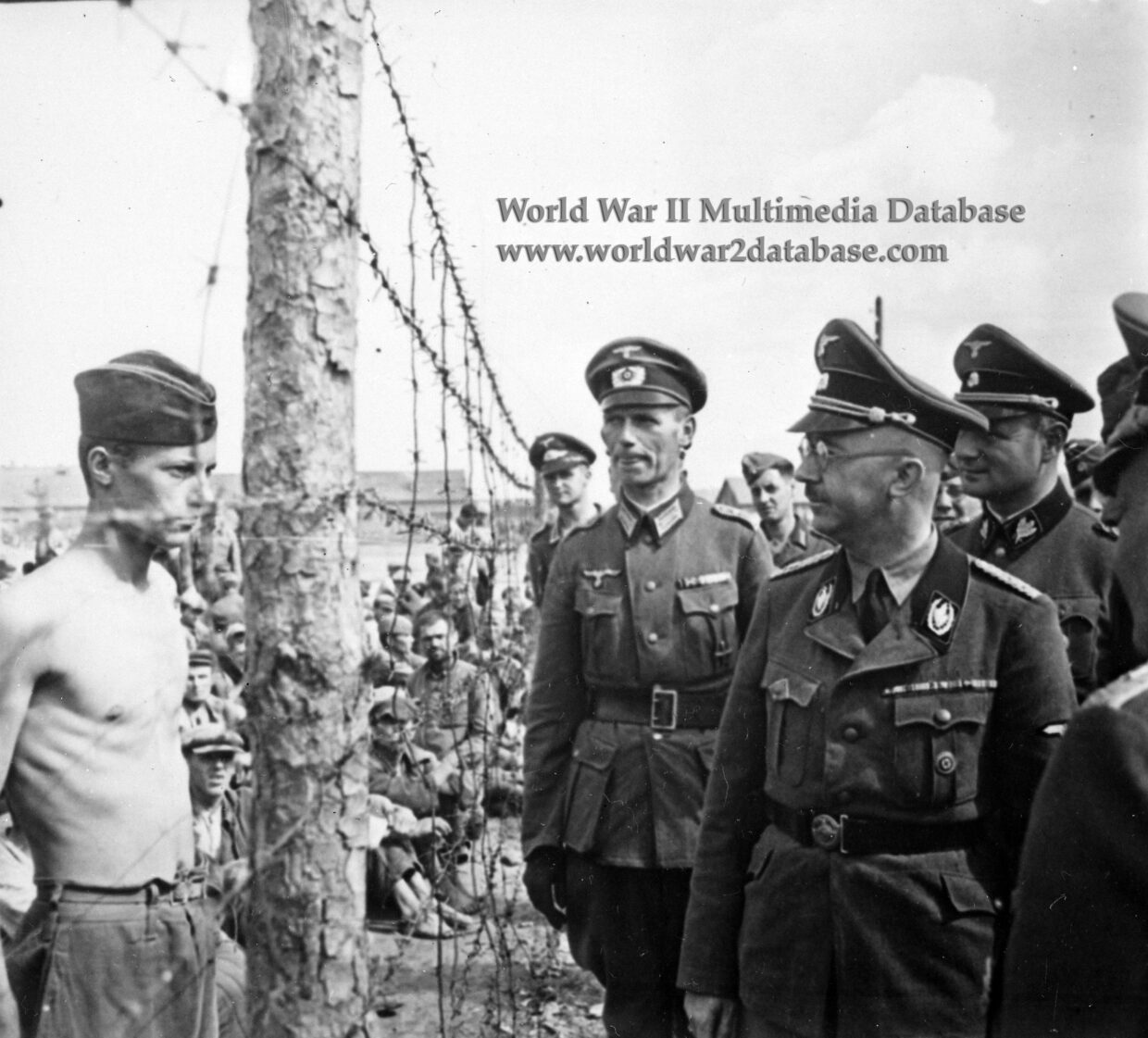| Reichsfuhrer-SS Heinrich Himmler (October 7, 1900 – May 23, 1945) inspects the Shirokaya Street Concentration Camp in Minsk, Byelorussia, on or about August 15, 1941. In this view, he is talking with a Soviet Prisoner of War. Shirokaya was a labor camp that held up to 2,000 prisoners; skilled laborers from the Minsk Ghetto and captured Red Army soldiers that refused to work or operated with the partisans in the forests of Byelorussia. Jews about to be shipped to Sobibor or Auschwitz from Byelorussia were also temporarily held there. While on this inspection tour, Himmler was accompanied by SS-Obergruppenfuhrer Karl Wolff (May 13, 1900 – July 17, 1984) who served as Himmler‘s Chief of Staff. Wolff can seen in this view behind Himmler, with his face partially obscured. That same day, Himmler ordered Einsatzgruppe B Gruppenfuhrer Arthur Nebe (November 13, 1894 – March 21, 1945) to demonstrate his unit‘s technique for shooting Jews; Nebe selected 98 Jewish men and two women. According to Wolff, Himmler attended the massacre and questioned one of the condemned, a blond youth. Himmler asked, “Are you a Jew?“ The man answered, “Yes.“ Himmler asked, “Are both your parents Jews?“ Again, he answered, “Yes.“ Himmler asked, “Do you have any ancestors who were not Jews?“ “No.“ the man answered. “Then I can‘t help you.“ Himmler said. The blond youth and the other 99 prisoners were shot in the back of the head. As each line of prisoners were executed, they were covered with dirt and another group brought out from far enough away that they could not hear the gunfire. Himmler, looking closely into the trench where the bodies lay, was nauseated when brain matter and blood sprayed his uniform. Wolff claims it was Himmler‘s first view of a dead body. Luftwaffe cameraman Walter Frentz (August 21, 1907 – July 6. 2004) who was a favorite lensman of the Nazis and was the cinematographer on Triumph Des Willens (1934) shot film of the Minsk executions that he later destroyed. He was asked by a shaken and upset Einsatzgruppen B member for help with an immediate transfer. SS-Obergruppenfuhrer Erich von dem Bach-Zelewski (March 1, 1899 – March 8, 1972), who also attended the massacre, claims to have pleaded with Himmler for an end to the killings, not for the sake of the Jews but for the executioners. Von dem Bach-Zelewski claimed the men of the Einsatzgruppen would become alcoholics or ruffians, saying they were “fertig,“ (finished). Himmler addressed Einsatzgruppe B after the shootings, saying their work was distasteful but necessary, and that he himself, and Reichsklanzler (Reichchancellor) Adolf Hitler were to blame. Afterwards, Himmler ordered Nebe to try to find a “more humane“ solution to mass killing and Nebe suggested dynamite. After two horrific tests using TNT to kill Jews in bunkers outside Minsk, Nebe and German scientists began to experiment with carbon monoxide. Eventually gas would be the preferred mode of execution during the Holocaust; most of the 90,000 Jews and 300,000 Soviet soldiers captured when Minsk fell on June 27, 1941 were killed or deported by the time Minsk was liberated in 1944. Everywhere Himmler visited during the summer of 1941, killings of Jews increased into the tens of thousands. Everyone behind the wire fence in this photo was likely to be killed by the Nazis before 1943. | |
| Image Filename | wwii0205.jpg |
| Image Size | 3.51 MB |
| Image Dimensions | 2904 x 2625 |
| Photographer | Frentz, Walter |
| Photographer Title | |
| Caption Author | Jason McDonald |
| Date Photographed | August 15, 1941 |
| Location | Shirokaya Street Concentraion Camp |
| City | Minsk |
| State or Province | Byelorussia |
| Country | Soviet Union |
| Archive | National Archives and Records Administration |
| Record Number | 242-HB-47721(306) |
| Status | Caption ©2007, ©2024 MFA Productions LLC Image in the Public Domain |

Author of the World War II Multimedia Database

